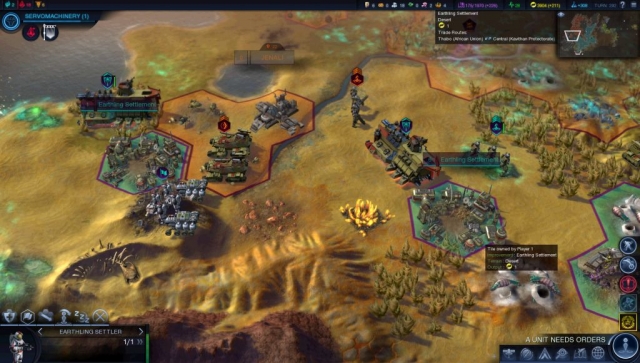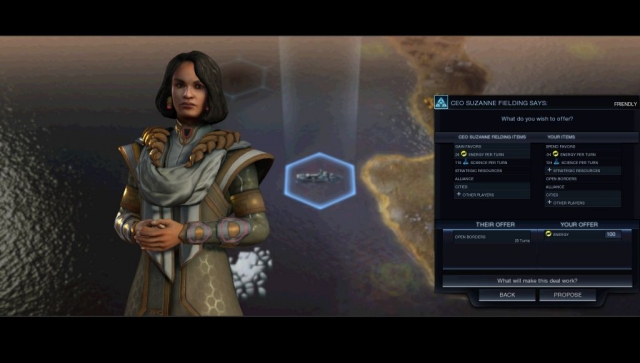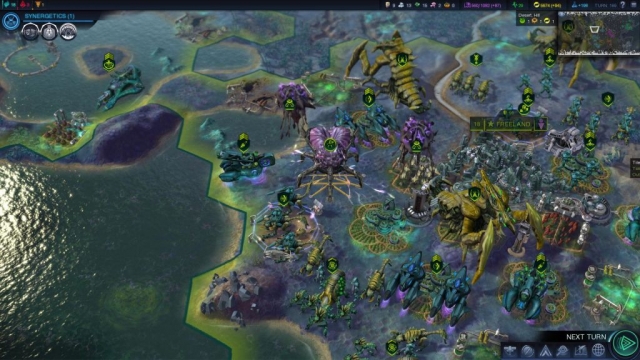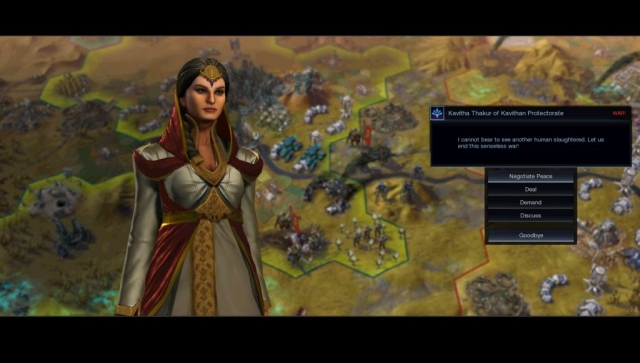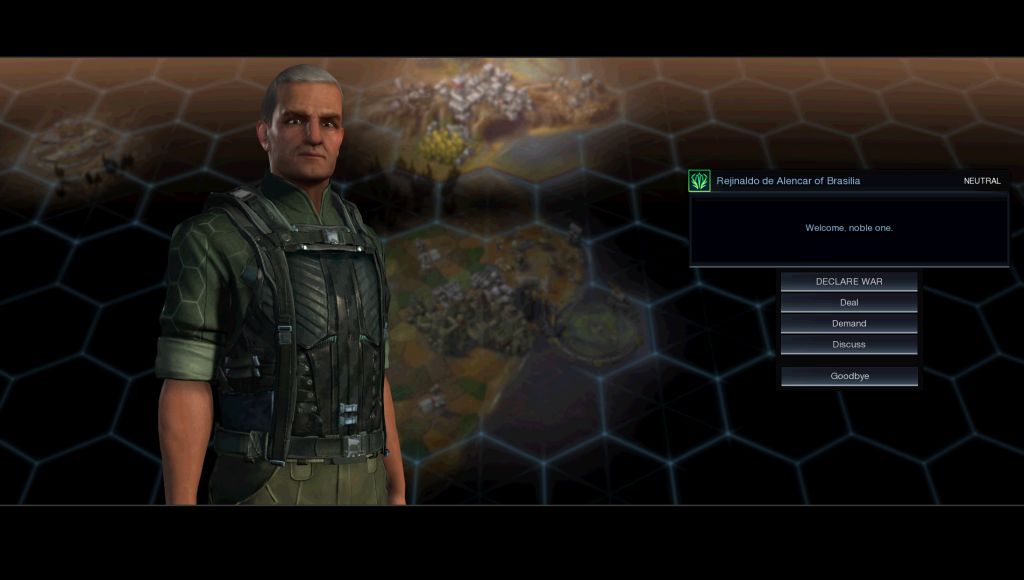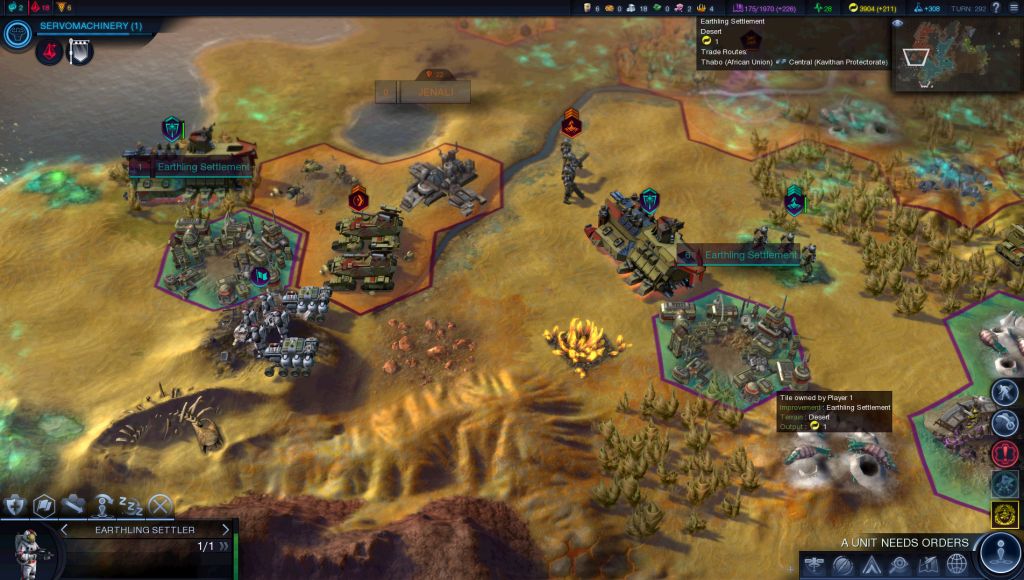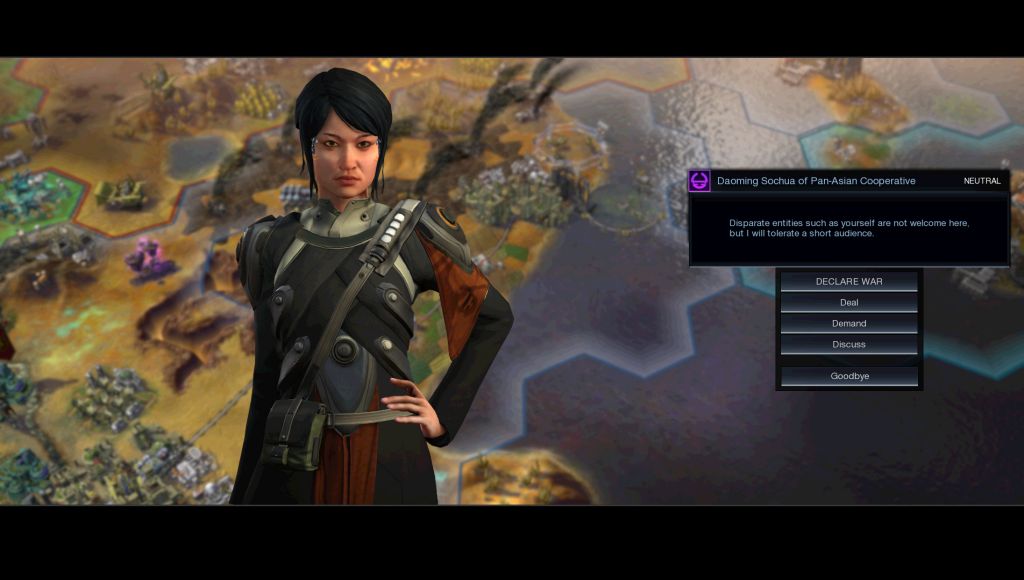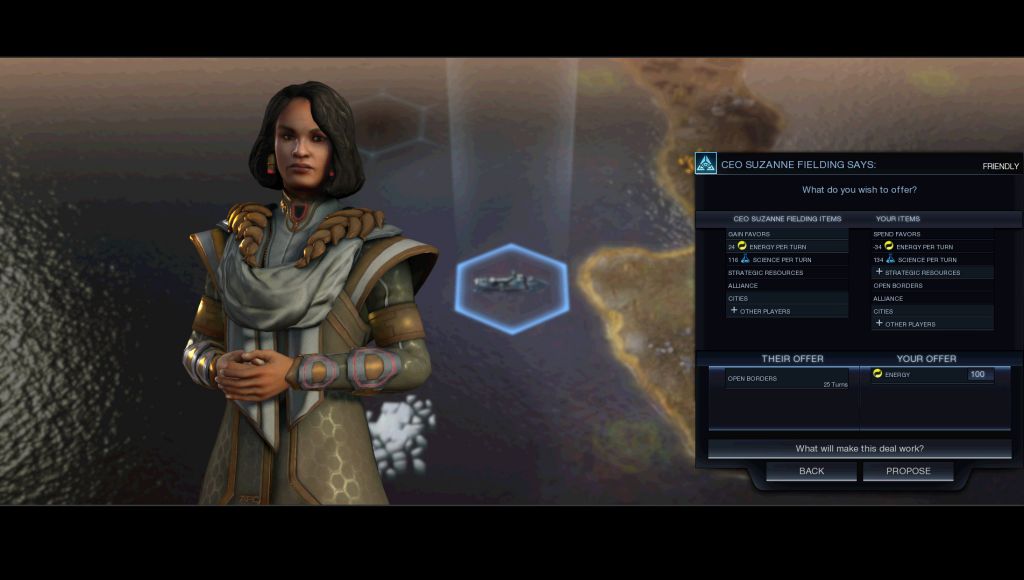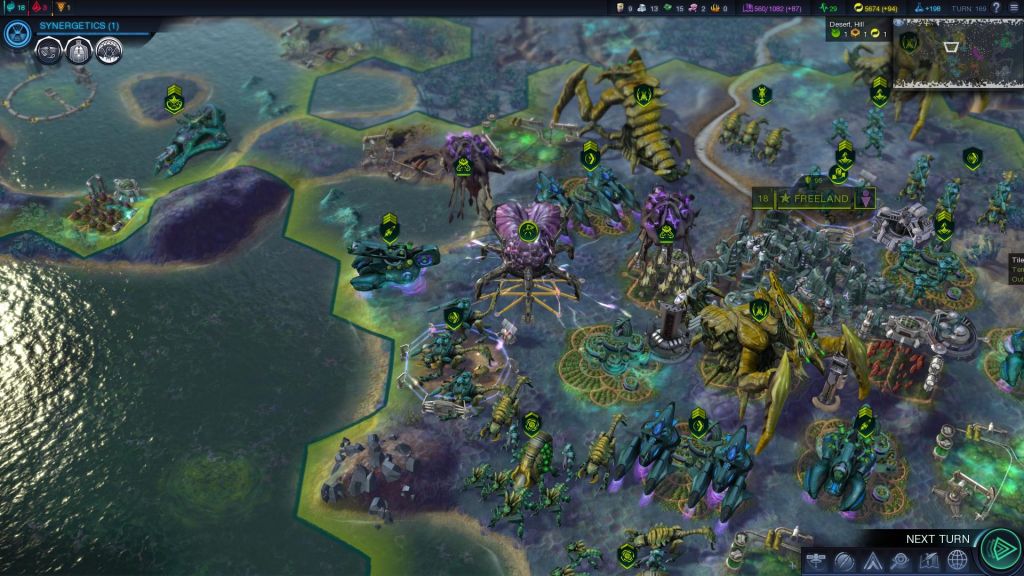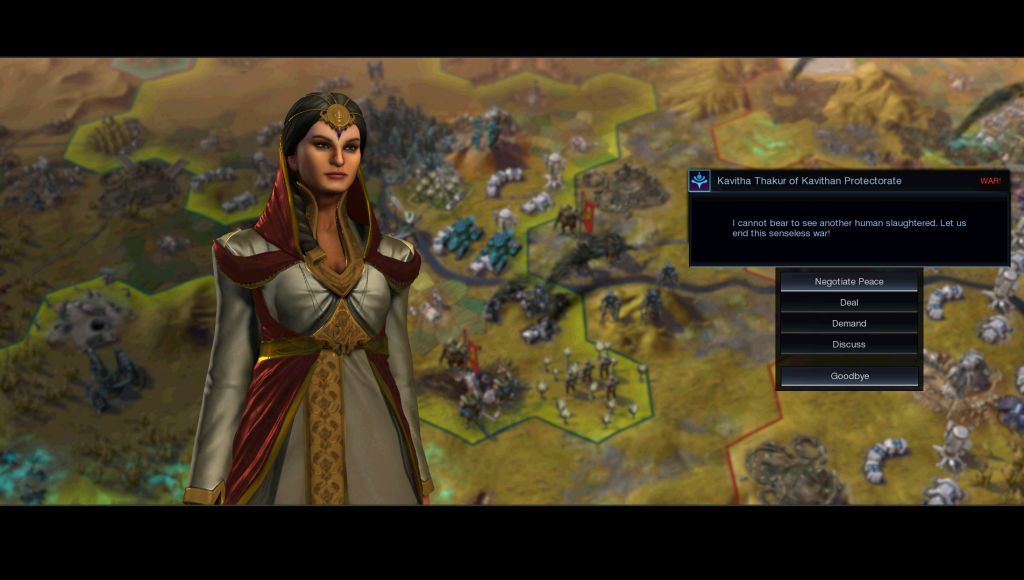Sid Meier’s Civilization: Beyond Earth
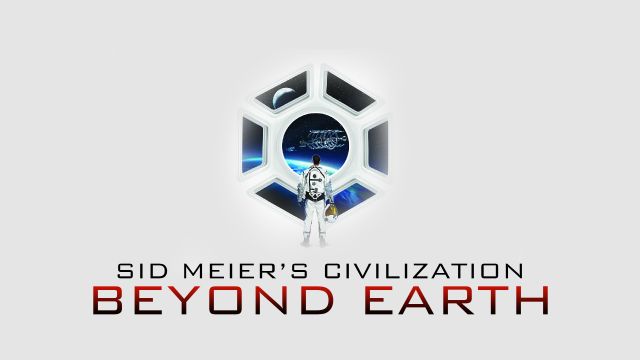
I’ll be honest – Civilization: Beyond Earth had a tough hill to climb with me, which is strange given how much of a Civilization 5 fan I am. Civ scenarios never held much interest for me. Maybe it’s the time limits, or the artificially confined rulesets, or the pre-defined landmasses, but for whatever reason, I can’t get very far into a mod or scenario before thinking, “I’d rather just be playing the normal game.” Even after attending Firaxicon and playing the game for a few hours, I was worried it would be a momentary diversion in my long wait for Civ 6. Thankfully, my fears have been allayed. Beyond Earth is good, but exactly how good is it?
The first major step in any game of Civ is picking your nation (or rather, “sponsor”, since the idea of formal nations is a bit anachronistic in the wake of humanity’s cataclysmic “Great Mistake”). The sponsor variety is initially quite underwhelming. Each faction starts with a rather piddly bonus, many of which don’t seem all that useful in later stages of the game. It’s only once you start picking your spaceship components, cargo, crew, etc. that the true differentiation starts. And that’s also a theme that runs throughout Beyond Earth: the player defines their destiny, not arbitrary heritages and historical traditions. The South Americans might have leaned a little more militaristic back on Earth, but that doesn’t mean they are destined to become space conquerors.
Once you land on your new home planet, the first hundred or so turns involve a combination of exploring and being very afraid of hostile aliens. These green, acidic, insectoid creatures are way stronger than you in the beginning and much more numerous. Unless you have a unique window of opportunity, it’s usually a bad idea to rush into a war with other factions because you’ll need every bit of resources you can muster just to survive. Which, for me, is a welcome gameplay texture, since I’m a “turtle” player at heart. Combine that with the challenges of dealing with the ever-present alien miasma (a dangerous green gas that covers roughly half of the map), and you start to realize that your true battle is with the alien planet itself.
There are two new major changes from typical Civ play: affinities and the tech web. Affinities represent how you choose to envision humanity going forward. Do you want to be the best Earth-like humans you can be? Should humanity transition to a synthetic existence, transferring consciousness into computers, and where all actions are carried out via robots? Or should humans completely adapt to this new planet, becoming one with the aliens and miasma? So much in Beyond Earth rides on this decision. Your military upgrades differently, your progress through technology fundamentally alters course, and your diplomatic relations can turn on a dime, wiping away past transgressions in favor of a united philosophy. And as someone that’s always pined for a Civilization experience where a great deal of attention is payed to the visuals, even your buildings and units alter their appearance based on your affinity choices. My only gripe with affinities is that there aren’t enough of them. In any given game, half of the other factions could end up choosing your affinity, which makes for a visually boring (and much too peaceful) game.
The tech web isn’t nearly as revolutionary, conceptually. Instead of the linear progression of technology found in Civilization, Beyond Earth starts you in the center of a giant cluster of techs and has you expand outwards. Pretty simple change, right? What I didn’t realize until playing a few full games is how drastically different the other factions can seem when they’ve been researching on the other side of the web. While I’ve been gunning for food and health-enhancing techs, they’ve been researching fighter jets and laser satellites. If I’ve been maximizing affinity-boosting techs, they’ve been learning of, and consistently building, wonders. Now more than ever, what you choose to research, in addition to which virtues (BE’s version of social policies) you grab, has a dramatic effect on your experience, probably more so than your affinity choice.
The remaining gamplay mostly resembles the Civilization 5 architecture that spawned it. Build cities, fight wars, establish trade routes, parlay diplomacy (you can now uses IOU-type “favors” as a currency, which is something that should totally be patched into Civ 5), conduct espionage, and otherwise piece together your new empire. While the core mechanics remain largely the same, there are new little wrinkles which can be fun to experiment with (such as spies being able to set off dirty bombs or summon alien worms to attack an opponent’s city). The features that fit from Civ 5 were carried over and adjusted. The features that no longer fit (like religion) were left back on Earth, which is thematically appropriate given the narrative of space-faring settlers taking only what they can carry to their new home.
So, here’s the part where I tear Beyond Earth up a little. As I mentioned above, I love visual flair and attention to detail. Whether you go to that extra effort, or more importantly, when you don’t, it’s pretty obvious. BE does most things well, but it’s the slow accumulation of “almosts” and “half-way theres” that drag it down from greatness.
The most egregious offender is the GUI (graphical user interface). So much time and energy seemed to go into making Civilization 5’s art deco UI look fantastic. From the soft golden curves of the menu borders, to the wonderfully drawn, big, bright unit and building icons, everything seemed to coalesce around the idea of optimism and hope. Smash-cut to Beyond Earth’s dark, blue-gray monotone. There are no more pictures for units and buildings, just random geometric shapes and icons. When glancing at the tech web in an effort to decide what to research, all you’ll see is dozens of these personality-less icons. You must tooltip-mouseover every icon a few times to even understand which techs give you units, buildings or wonders. Further, the only way to know if something is a building or a wonder is to guess, based on how much production is needed to build it. Oh, and I hope you’re cool with forgoing a functional minimap, because the one in Beyond Earth is a nigh-useless mess of dark blue-grays against even darker blues. This is amateur-level UI design and frankly, I’m a little shocked by Firaxis on this front. They’ve routinely done better and this isn’t a minor mistake, easily fixed in a patch. This is a design decision that no one had the balls to call foul on.
To further emphasize how bad the GUI issue is, every other problem seems to be a ripple effect of that original poor decision. Leader screens are now woefully anemic, amounting to the upper two thirds of a human being, suspended against the blurry background of the game map. No background scenes, a la Civ 5, not even a hologram effect or the frame of a futuristic monitor to imply the means of communication. No, these leaders of humanity are just there, staring at you, apropo of nothing. That same UI designer must have declared, “Guys, we’re doing minimalism. I don’t want to see any of you going the extra mile in the name of immersion!”
The art of the world, itself, is a fairly muddled. I’m a little more sympathetic to Firaxis on this count, though, since it seems like a tough nut to crack: how do you represent three different biome-planets (fungal, arid and lush), that each come with plains, grasslands, hills, mountains, craters, deserts, tundra, and snow, and then layer on top of that a green fog of miasma? I certainly don’t have a good solution to that conundrum. But it still remains that when quickly glancing at any particular piece of alien terrain, it’s hard to know what you’re looking at. I imagine that in time, my eye will become sophisticated enough to tell the difference, like a wine connoisseur who is able to detect “hints of oak”, but for the first 50+ hours, I had to tooltip every hex of land.
Finally, I wouldn’t recommend this game to Civilization newbies. Whereas in standard Civ games, you start out making simple decisions for the first 50 turns and the game slowly ramps up the complexity, Beyond Earth throws you into the deep-end right from turn 1. The tech web is an overwhelming tangle of white icons, the virtues are all unlocked from the start, making you choose between 4 different, long paths, and exploration is even intimidating due to the aliens and miasma. I can easily see a newcomer becoming quickly subsumed by decisions before they’ve even grasped the concepts of city management or worker improvements.
Some few minor quibbles are bugs related to broken animations, and, of course, AI that often makes poor tactical use of its military (a common refrain in Civilization). Also, I noticed that the AI seemed pretty passive in general, rarely going to war amongst themselves or even declaring friendship all that often. I’m sure most of this will get better as patches are released, but it’s worth pointing out nonetheless. Lastly, I was a bit disappointed with how little voice acting is present. Yes, all of the affinity level, tech and wonder quotes are read aloud by the game’s Indian-accented female narrator, but the faction leaders themselves speak only occasionally, and only a sentence or two at most. This was all the more disappointing because there are only eight of them, and unless I read the civilopedia entries on each of them, I don’t really get a flavor for their personalities at all (aside from, “Oh, the Australian and American leaders are all about money”). More than half of the time, the leader merely gesticulates at me while I read the text detailing what they want from me.
Alright, that’s enough complaining. Let’s end this review on a high note: the music. I’m not sure if it’s a compliment or a subtle insult to say that the music is probably my favorite thing about Beyond Earth. And I want to set the right context – I don’t even like music as an artistic medium very much. There are a few bands I like well enough, but I almost never listen to music recreationally. However, when it comes to Beyond Earth, I want to put the tracks on my MP3 player (alongside my usual podcasts and audiobooks) and listen to it while driving. Whereas Civ 5’s music added a nice audio texture to the gameplay, BE’s music felt like the main force driving my actions. It’s probably good that I don’t review music because I’m realizing as I write this that I’m essentially just repeating, “It’s really good!” over and over, but it is. If you have a chance to listen to some of the more triumphant tracks before buying, you’ll want the game that much more.
Civilization: Beyond Earth is a game that grew on me. I started skeptical, fearing it would simply be a gussied-up Civ 5 mod. But I’m now convinced it’s a damn fine game in its own right. Horrible GUI aside, it accomplishes everything it sets out to, perhaps most importantly, feeling very different from Civ 5 (while, obviously, still similar enough to retain the prefix name). I can’t say for certain that it’s a must-buy for everyone, as $50 for an off-shoot game is asking quite a bit. But for hardcore Civilization fans, it’s pretty much a no-brainer. And I know that chances are exceedingly low, but I’m still hoping for a UI redesign and true leader screens at some point. Bring on those patches!
Reviewed By: Brian Mardiney
Publisher: 2K
Rating: 85%
——————————————————————————–
This review is based on a digital copy of Sid Meier’s Civilization: Beyond Earth for the PC provided by 2K.
 Game Over Online
Game Over Online